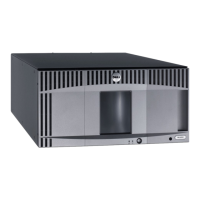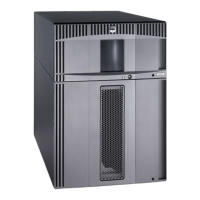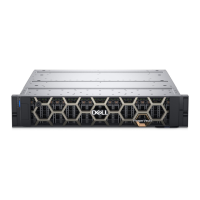Understanding the User Interface
file:///T|/htdocs/stor-sys/ML6000/en/html/ch03.htm[9/17/2012 1:49:22 PM]
Web Client
The Web client user interface is similar to the operator panel user interface. The Web client interface is accessible from
supported Web browsers. See
System Requirements for information about supported browsers.
To manage the library from a remote location, you must set up the library's initial network configuration from the operator
panel touch screen. See Configuring Library Security Settings for information on setting the network configuration settings for
remote use.
You must disable Web browser popup blockers to use the Web client interface and the library's online Help. Add the
PowerVault ML6000's Internet Protocol (IP) address to the list of trusted/allowed sites on your PowerVault ML6000-supported
browser, so the Web client pages will automatically refresh.
Note: Do not use your internet browser Back button to navigate the Web client pages. Instead, use the buttons
provided within the Web client.
Note: Log out of the library before closing the internet browser window when you are using the Web client. If you do
not log out, the session will remain open.
Menu Trees
The following menus organize operations and commands into logical groupings:
• The Setup menu consists of commands that administrators can use to set up and configure various aspects of the
library, including partitions, I/E station slots, cleaning slots, control paths, network settings, drive settings, users,
notifications, date and time, licenses, FC I/O blades, and e-mail.
• The Operations menu consists of commands that enable users to change the library's mode of operations, import and
export cartridges, load and unload tape drives, move media, perform diagnostics, and log off. Administrators can also
access commands to lock or unlock the I/E station and to shut the library down.
• The Tools menu consists of commands that you can use to maintain your library, such as viewing RAS Tickets,
generating diagnostic logs, identifying drives, configuring the internal network, saving and restoring the library
configuration, setting system and security settings, and updating firmware.
• The Reports menu (Web client only) consists of summaries of library information.
The menus vary somewhat between the Web client and operator panel user interfaces. Administrators have access to all
menu commands; users with user privileges have more limited access.
Table 1 lists the Web client menus. Some menu commands are available only to administrators.
I/O blade menu items are available for libraries that contain I/O blades.
Table 1 Web Client Menus
Setup Menu* Operations Menu Tools Menu* Reports Menu
• Setup Wizard
• Partitions
• Cleaning Slots
• I/E Station Slots
• Drive Settings
• Control Path
• License
• Notifications
• E-mail Configuration
• Advanced Reporting (if
licensed)
• Media
• Move
• Import
• Export
• Cleaning Media
• Import
• Export
• Partitions
• Change Mode
• Drive
• Load
• All RAS Tickets
• Capture Snapshot
• Save/Restore
Configuration
• E-mail Configuration
Record
• Save Configuration
Record
• Identify Drives
• Drive Operations
• Download SNMP MIB
• IO Blade Info**
• System Information
• Library Configuration
• Network Settings
• Logged in Users*
• All Slots
• Log Viewer*
• Advanced Reporting*
• Drive Resource Utilization
• Media Integrity Analysis
• About

